2020学年人教版高中英语必修三unit1单元说课稿
2020年人教版高中英语必修三unit1reading 说课稿
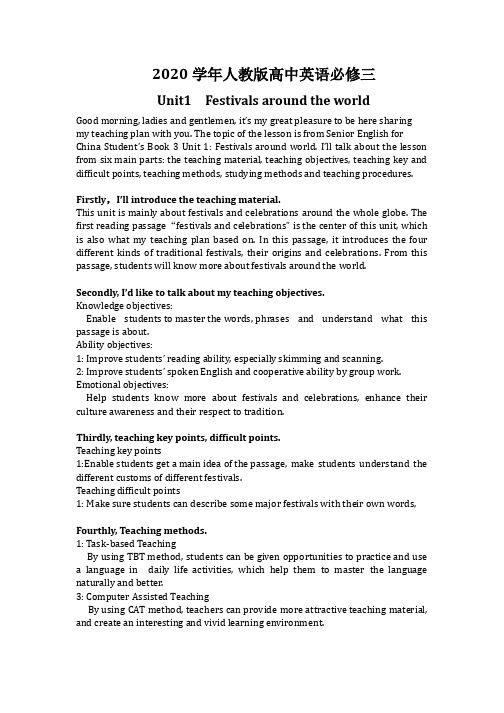
2020学年人教版高中英语必修三Unit1 Festivals around the worldGood morning, ladies and gentlemen, it’s my great pleasure to be here sharing my teaching plan with you. The topic of the lesson is from Senior English for China Student’s Book 3 Unit 1: Festivals around world. I’ll talk about the lesson from six main parts: the teaching material, teaching objectives, teaching key and difficult points, teaching methods, studying methods and teaching procedures. Firstly,I’ll introduce the teaching material.This unit is mainly about festivals and celebrations around the whole globe. The first reading passage“festivals and celebrations” is the center of this unit, which is also what my teaching plan based on. In this passage, it introduces the four different kinds of traditional festivals, their origins and celebrations. From this passage, students will know more about festivals around the world. Secondly, I’d like to talk about my teaching objectives.Knowledge objectives:Enable students to master the words, phrases and understand what this passage is about.Ability objectives:1: Improve students’ reading ability, especially skimming and scanning.2: Improve students’ spoken English and cooperative ability by group work. Emotional objectives:Help students know more about festivals and celebrations, enhance their culture awareness and their respect to tradition.Thirdly, teaching key points, difficult points.Teaching key points1:Enable students get a main idea of the passage, make students understand the different customs of different festivals.Teaching difficult points1: Make sure students can describe some major festivals with their own words, Fourthly, Teaching methods.1: Task-based TeachingBy using TBT method, students can be given opportunities to practice and use a language in daily life activities, which help them to master the language naturally and better.3: Computer Assisted TeachingBy using CAT method, teachers can provide more attractive teaching material, and create an interesting and vivid learning environment.Fifthly, studying methods.1: Task-based learning.2: Cooperative learningSixthly, Teaching procedures.1: Lead-inShow students a short video some traditional festivals’ celebrations. After watching that, ask students questions like “have you ever had these festivals?” “what do you do at these festivals?” “how do you know about these festivals?”Justification: in the beginning of the class, I want to use online video to create a lively environment in which students can get involved in more quickly, and also activate students interest and background knowledge of the topic.2: While-reading.Task 1 SkimmingDivide students into 8 groups, give them 3 minutes to glance over the title and each paragraph, then try to discuss and sum up the main idea of each and the theme of the whole passage.Justification: practice students’ ability of reading for the general idea, moreover, by group disc ussion, turn passive study to active study, and enhance students’ spoken English and the consciousness of cooperative learning.Task 2 ScanningGive students 8 minutes to read the passage carefully, then ask them questions like:1, what festivals are held to honour the dead and ancestors?2, who is honoured in India in October 2?3, what do European people do to celebrate harvest?4, what festivals are celebrated in Spring?Justification: practice students’ ability of reading for specific information. And also, by answering those questions students can have a better understanding of festivals around the world.3: Post-reading.Divide students into 8 groups, ask students to find out and discuss all the festivals and celebrations mentioned in the passage. After that, each group sends a representative to describe two festivals in front of the whole class. Justification: deepen students’ knowledge of today’s class. Make sure students can talk about festivals and celebrations by using their own words. Encourage students to express themselves in the face of people and to cooperate with others.4: Consolidation.Ask students to review the passage very quickly then complete the exercise below.Justification: review and consolidate the knowledge we’ve just learnt.5: Homework.Write an essay to introduce a festival and how it is celebrated.Justification: this activity does not only strengthen students’ understanding of different kinds of festivals and celebrations, but also improve students’ interculture awareness.。
人教版高中英语必修三Unit1Festivalsaroundtheworld
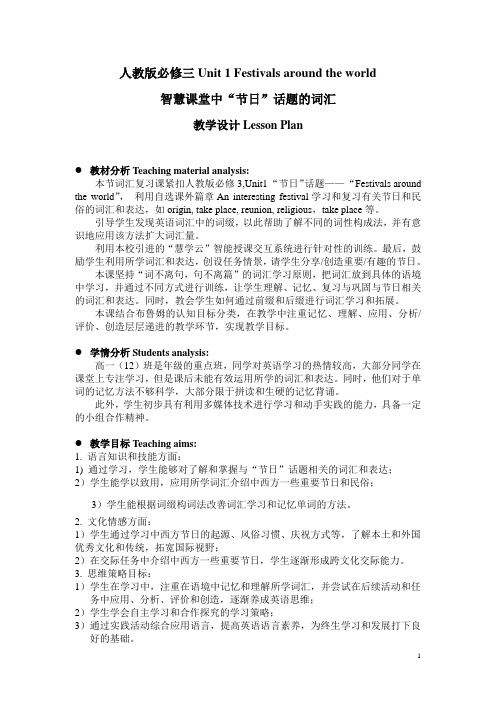
人教版必修三Unit 1 Festivals around the world智慧课堂中“节日”话题的词汇教学设计Lesson Plan●教材分析Teaching material analysis:本节词汇复习课紧扣人教版必修3,Unit1 “节日”话题——“Festivals around the world”,利用自选课外篇章An interesting festival学习和复习有关节日和民俗的词汇和表达,如origin, take place, reunion, religious,take place等。
引导学生发现英语词汇中的词缀,以此帮助了解不同的词性构成法,并有意识地应用该方法扩大词汇量。
利用本校引进的“慧学云”智能授课交互系统进行针对性的训练。
最后,鼓励学生利用所学词汇和表达,创设任务情景,请学生分享/创造重要/有趣的节日。
本课坚持“词不离句,句不离篇”的词汇学习原则,把词汇放到具体的语境中学习,并通过不同方式进行训练,让学生理解、记忆、复习与巩固与节日相关的词汇和表达。
同时,教会学生如何通过前缀和后缀进行词汇学习和拓展。
本课结合布鲁姆的认知目标分类,在教学中注重记忆、理解、应用、分析/评价、创造层层递进的教学环节,实现教学目标。
●学情分析Students analysis:高一(12)班是年级的重点班,同学对英语学习的热情较高,大部分同学在课堂上专注学习,但是课后未能有效运用所学的词汇和表达。
同时,他们对于单词的记忆方法不够科学,大部分限于拼读和生硬的记忆背诵。
此外,学生初步具有利用多媒体技术进行学习和动手实践的能力,具备一定的小组合作精神。
●教学目标Teaching aims:1. 语言知识和技能方面:1) 通过学习,学生能够对了解和掌握与“节日”话题相关的词汇和表达;2)学生能学以致用,应用所学词汇介绍中西方一些重要节日和民俗;3)学生能根据词缀构词法改善词汇学习和记忆单词的方法。
新人教版高中英语必修三Unit1Festivals and Celebrations单元分析讲义
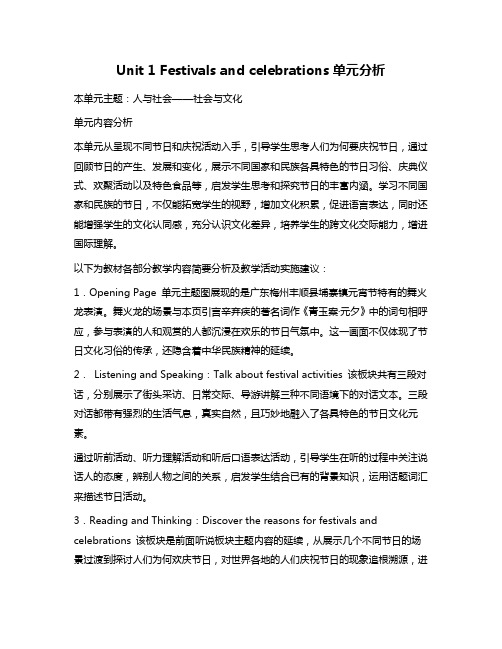
Unit 1 Festivals and celebrations单元分析本单元主题:人与社会——社会与文化单元内容分析本单元从呈现不同节日和庆祝活动入手,引导学生思考人们为何要庆祝节日,通过回顾节日的产生、发展和变化,展示不同国家和民族各具特色的节日习俗、庆典仪式、欢聚活动以及特色食品等,启发学生思考和探究节日的丰富内涵。
学习不同国家和民族的节日,不仅能拓宽学生的视野,增加文化积累,促进语言表达,同时还能增强学生的文化认同感,充分认识文化差异,培养学生的跨文化交际能力,增进国际理解。
以下为教材各部分教学内容简要分析及教学活动实施建议:1.Opening Page 单元主题图展现的是广东梅州丰顺县埔寨镇元宵节特有的舞火龙表演。
舞火龙的场景与本页引言辛弃疾的著名词作《青玉案·元夕》中的词句相呼应,参与表演的人和观赏的人都沉浸在欢乐的节日气氛中。
这一画面不仅体现了节日文化习俗的传承,还隐含着中华民族精神的延续。
2.Listening and Speaking:Talk about festival activities 该板块共有三段对话,分别展示了街头采访、日常交际、导游讲解三种不同语境下的对话文本。
三段对话都带有强烈的生活气息,真实自然,且巧妙地融入了各具特色的节日文化元素。
通过听前活动、听力理解活动和听后口语表达活动,引导学生在听的过程中关注说话人的态度,辨别人物之间的关系,启发学生结合已有的背景知识,运用话题词汇来描述节日活动。
3.Reading and Thinking:Discover the reasons for festivals and celebrations 该板块是前面听说板块主题内容的延续,从展示几个不同节日的场景过渡到探讨人们为何欢庆节日,对世界各地的人们庆祝节日的现象追根溯源,进而谈论节日的传承与发展变化,目的在于启发学生的深层思考,体会节日文化的内在实质,感悟世界各国人民共同的精神追求和美好愿望。
2020年新人教版必修三《Unit 1 Festivals and Celebrations》单元教案(附导学案)1

Unit 1 Festivals and CelebrationsListening and speaking & Listening and talking【教材分析】本板块的活动主题是“谈论节日活动”(Talk about festival activities),主要是从贴近学生日常生活的角度来切入“节日”主题。
学生会听到发生在三个国家不同节日场景下的简短对话,对话中的人们正在参与或将要亲历不同的庆祝活动。
随着全球化的进程加速,国际交流日益频繁,无论是国人走出国门还是外国友人访问中国,都已成为司空见惯的事情。
因此,该板块所选取的三个典型节日场景都是属于跨文化交际语境,不仅每组对话中的人物来自不同的文化背景,对话者的身份和关系也不尽相同。
【教学目标】1. Master the new words related to holiday: lantern, carnival, costume, dress (sb) up, march, congratulation, congratulate, riddle, ceremony, samba, make-up, after all.2. To understand the origin of major world festivals and the activities held to celebrate them and the significance of these activities;3. Improve listening comprehension and oral expression of the topic by listening and talking about traditional festivals around the world;4. Improve students’ understanding of the topic by watching pictures and videos about different traditional festivals around the world;5. Review the common assimilation phenomenon in English phonetics, distinguish the assimilated phonemes in the natural language flow, and consciously use the assimilation skill in oral expression.【教学重难点】Importance:1. Guide students to pay attention to the attitude of the speaker in the process of listening, and identify the relationship between the characters;2. Inspire students to use topic words to describe the festival activities based on their background knowledge.Difficulties:In the process of listening to the correct understanding of the speaker’s attitude, accurately identify the relationship between the characters.【课前准备】1. To understand the origin of traditional festivals in the world, the celebration activities (customs) of these festivals and the meaning of these activities;2. Talk about holiday celebrations;3. Preview: understand the new words according to the context.【教学过程】Step 1 Lead-inTeachers talk about the world’s traditional festivals, such as the Lantern Festival in China, adults’ day in foreign countries, carnivals and so on.Step 2 Watching and talkingActivity 11. Teacher lets Ss look at some pictures about festival activities. During talking about these activities, teacher can add some background knowledge about festivals.Questions:①What festivals do the pictures show us?②In which country do you think people celebrate each festival?③How do people celebrate each festival?2. Ask sb to choose some words or phrases from the box to celebrate eachfestival.3. Teacher can show students how to use these word blocks and learn to describeholiday activities in groups. For example:On the Coming-of-Age Day, young girls in Japan would wear traditional costumes.One of the most important activities during the Lantern Festival is to guess riddles.During the Rio Carnival, you can watch wonderful samba dances.4. The teacher asks students to report the results of the group lecture. Ask thesequestions:①What do people do to celebrate the Chinese Lantern festival?②Who will celebrate Coming-of-Age Day? What do they do to celebrate it?③What do you expect to see if you go to the Rio Carnival?5. Learn some words and phrases in the box.Step 3 ListeningActivity 21. Teacher asks sb to read “Listen for relationships”, In pairs, discuss how to identify relationships between people based on their tone and content. The teacher can provide the following questions to inspire students to discuss.①What does a tour guide usually say to a tour group? What expressions arefrequently used?②What questions does an interviewer usually ask during an interview?③What would a reporter say or do if he/she wants to interview a tourist?④How do friends usually talk?2. Some group representatives are invited to communicate and speak in class.3. Teacher plays the listening tape for students to listen to and write the order of the conversations next to the names of the festivals.4. Play the tape again, students match each conversation with the relationship between the speakers.5. Check the answers with class.Activities 3-41. Teacher asks students to look at the tasks and requirements of activity 3. Then read the main ideas of the three dialogues. (Guide the students to guess and fill in the words according to the context. Let the students analyze the English syntactic structure based on the meaning of the sentence and make reasonable inferences.)2. Teacher plays the tape for the second time. After listening to the tape, students discuss the answers in pairs. Then the class communicates and checks the answers.3. Teacher lets students listen to the tape for the third time (Before the teacher plays the recording for the third time, the teacher should prepare the students to takenotes and remind them to catch key words, especially phrasal verbs.).Step 4 SpeakingActivity 51. Lead the dialogue by asking questions. Let students understand how to discuss their favorite festivals and give their reasons.E.g.,Conversation 1T: Which of the three festivals do you like best?S1: I think the Coming-of-Age Day is the most interesting.T: Why is it your favourite?S1: Because I like to see women dressed up in their colorful traditional kimonos.Conversation 2T: Which of the three festivals attracts you most?S2: The Chinese Lantern Festival.T: I suppose you like yuanxiao, the sweet dumplings.S2: Not only that. I especially like guessing riddles and I’m good at it.2. Follow the example of the conversation in activity 5 and work in pairs to discuss your favorite holiday and explain why. After the discussion, the teacher asks some groups to show the dialogue.Step 5 ActingOne student plays the role of a journalist. The other three students play the roles of the characters in the listening dialogue. They are the Japanese girl attending the coming-of-age ceremony, the girl attending the Rio carnival, and the tourist visiting China. The following questions can be used in the interview:①What is the purpose of this festival?②How do you usually celebrate this festival?③What do you like best about this festival?Step 6 Pronunciation1. Help students recognize speech assimilation.(1)Teacher plays the recording of activity 1 and asks the students to pay attention to the pronunciation changes of bold letters while listening.(2)Teacher organizes students to carry out activities in pairs: the teacher plays the recording, one person in the group reads after the words and phrases in activity 1, the other person compares the pronunciation of the recording with that of his partner carefully, and points out the pronunciation problem of his/her partner if there is any difference. Then switch roles, listen to the tape again and complete the same task.2. Let students imitate and read.(1)Teacher guides students to understand the requirements of activity 2. Before listening to the tape, the teacher asks the question for students to think: “How does your pronunciation change while reading the sentences?”(2)Teacher plays the tape for the first time. The students read after the sentences in activity 2.(3)Teacher plays the tape for the second time, the students repeat the sentences again, and then discuss with their partners the differences between the pronunciation of the bold consonants in words and the pronunciation in sentences, and describe the phonetic assimilation in the flow.(4)Teacher asks different students to read the six sentences of activity 2 and report the result of the discussion on phonetic assimilation. The teacher supplements and corrects the students’conclusion, explains it appropriately, and writes the assimilation pronunciation in these sentences on the blackboard or presents it to the students through the courseware.Step 7 Listening and TalkingActivity 61. Learn the new words about the festivals.2. Look at the pictures and predict what festival Song Lin and Max are going to talk about.3. Listen and answer the questions.①What festival is Max talking about?②What did Max’s mother cook?③What did Max do during the festival?④What did Max and his family do during and after the dinner?⑤What was the best part of the festival?4. Listen again and check the answers with class.Answers:①Christmas experiences.②Roast turkey, mashed potatoes and Christmas pudding, …③He helped decorate the Christmas tree and put presents under it, then helped his mum prepare for the family dinner.④During dinner they shared stories and told jokes, afterwards they played games, opened their presents.⑤The best part was opening their presents on Christmas morning.5. Listen again and tick the phrases that Max or Song Lin uses. Then check the answers with class.6. Have a conversation with the help of these questions:①What is the recent festival you have had?②How did you celebrate it?③How do you feel about the festival? Why?Step 8 Homework1)Read the passage again and understand the food culture from a cross-cultural perspective.2)Remember the new words and learn the usages of them.【教学反思】1、通过本节内容学习,学生能否理解发生在三个国家不同节日场景下的简短对话,对话中的人们正在参与或将要亲历不同的庆祝活动;2、通过本节内容学习,学生能否辨别对话中人物之间的关系;3、通过本节内容学习,学生能否掌握听力训练中的听力策略。
高中英语必修三unit1教案

高中英语必修三unit1教案教案标题:高中英语必修三Unit 1教案教学目标:1. 了解并掌握Unit 1中的重点词汇、短语和句型;2. 能够运用所学知识描述人物特征和外貌;3. 能够运用所学知识进行听说读写的综合训练;4. 培养学生的合作意识和团队合作能力。
教学重点:1. 掌握重点词汇、短语和句型;2. 运用所学知识进行听说读写的综合训练。
教学难点:1. 运用所学知识进行听说读写的综合训练。
教学准备:1. 教材:高中英语必修三教材Unit 1;2. 多媒体设备;3. 教学课件;4. 学生练习册。
教学过程:Step 1: 导入新课1. 利用多媒体设备播放一段关于人物特征和外貌的视频或展示一些图片,激发学生对话题的兴趣;2. 引导学生讨论所展示的人物特征和外貌,并引出相关的词汇。
Step 2: 词汇学习1. 教师呈现并讲解Unit 1中的重点词汇,包括形容词、名词和动词;2. 学生跟读并模仿教师的发音;3. 学生进行词汇拓展活动,如根据给出的词根或词缀构造新词。
Step 3: 句型学习1. 教师呈现并讲解Unit 1中的重点句型,包括描述人物特征和外貌的句型;2. 学生进行句型操练活动,如根据给出的句子结构进行句子变换。
Step 4: 听说读写综合训练1. 教师设计听力活动,如听力填空或听力选择题,让学生通过听力理解并掌握所学知识;2. 学生进行口语练习,如两人一组描述对方的外貌特征;3. 学生进行阅读活动,如阅读课文并回答相关问题;4. 学生进行写作活动,如根据所给的人物描述写一篇短文。
Step 5: 合作学习1. 学生分组进行合作学习,如小组讨论和合作完成一些任务;2. 教师进行指导和辅导,鼓励学生积极参与合作学习。
Step 6: 总结和评价1. 教师对本节课的教学进行总结,强调重点和难点;2. 学生进行自我评价,反思自己在本节课中的学习情况和问题。
Step 7: 作业布置1. 布置课后作业,如完成练习册上的相关练习;2. 鼓励学生积极参加课外阅读,拓展自己的词汇和语言能力。
人教版 高中英语必修第三册 Unit 1 教案

必修三第一单元Why do we celebrate festivals?一、文本分析这是一篇说明文,从不同的侧面对节日进行说明。
第一段首先介绍节日的起源有季节、宗教、著名人物、重要事件,接着介绍节日的共性特点:分享快乐、感激、爱、和平等。
第二段举例说明全世界共同庆祝的节日丰收节的庆祝时间、原因和主要活动,同时举例说明古代埃及、现代欧洲和中国庆祝丰收节的情况。
第三段介绍习俗在节日形成中扮演着重要角色,但随着社会的发展,一些习俗逐渐消失,同时也产生些新的习俗,以中国春节为环保而禁止燃放鞭炮和万圣节变成了孩子的娱乐节日为例说明。
第四段介绍节日商业化现象。
最后一段说明节日的重要性和意义。
从节日的起源、共性特点、发展、重要性和意义等方面介绍节日,理解节日的文化内涵,比较节日的异同,让学生了解不同民族文化习俗与传统节日,拓宽国际视野,增强祖国意识和跨文化交际能力。
二、设计理念“问题链·导学”模式是以“为什么要庆祝庆祝节日?”这一问题为中心开展教学。
通过节日情境创设,把学生引导到提出问题、分析问题、感悟问题的活动中来。
让学生基于节日主题语境,通过学习理解、迁移创新等体现综合性、关联性等特点的英语学习活动,围绕标题为什么要庆祝节日展开,提炼庆祝原因,在分析问题和解决问题过程中,促进自身语言知识学习、语言技能发展、文化内涵理解、多元思维发展。
三、本堂课特色1.创设节日情境,激发阅读动机;2.围绕教学目标,借力思维导图,理清语篇思路,使文本信息结构化;3.以问题链为支架,深度阅读,融入语言,优化思维发展,探讨庆祝节日的原因;4.回归标题,针对“festival”首字母,回归课文,再次提炼庆祝节日的意义,升华主题。
四、教学目标1.获取段落大意,梳理节日的起源、共性特点、发展等信息;2.描述中外节日异同,理解不同节日的重要性;3.分析和总结庆祝节日的原因;4.写一篇介绍清明节的应用文。
五、教学步骤Step1:学习理解类活动1. 围绕主题创设情境,铺垫语言以临近的清明节为导入,Why do we celebrate Tomb Sweeping Day? How do we celebrate it?Step2:概括、梳理、整合信息1. 寻找段落大意总结阅读技巧。
人教版高中英语 必修三 Unit1《Festivals around the world ---Reading》 课件 (共37张PPT)
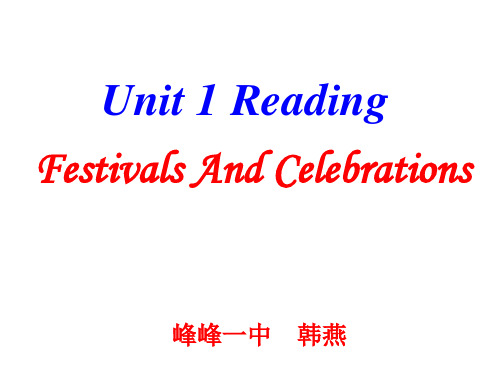
dragon dances.
Western countries
Parades, dancing , music, coloful
clothing.
Japan
Admire cherry tree flowers.
dragon dalnucceky money the Spring Festival
carnivals
1. Ancient festivals 2. Festivals of the Dead 3. Festivals to Honor People 4. Harvest Festivals 5. Spring Festivals
What festivals are mention in each paragraph?
Discussion :
Should we, Chinese students, celebrate western festivals like Christmas? Why or why not ?tival.
Unit 1 Reading Festivals And Celebrations
峰峰一中 韩燕
Labour Day
Tombsweeping
Day
Dragon Boat Festival
(The fifth day of the fifth lunar month)
Mid-autumn Festival
Day of the Dead
Eat food in the shape of
skulls and cakes with
Offer food, flowers
“_b_o_n_es_”_o_n__th_e_m____ _a_n_d_g_i_ft_s _to__th_e_d_e_a_d.
高中英语必修三unit1教案

高中英语必修三unit1教案教学目标1. 让学生掌握本单元的核心词汇和表达方式。
2. 培养学生通过语境理解词义和句意的能力。
3. 提高学生的听说读写综合运用能力,尤其是口语交际能力。
4. 引导学生了解和认识中西方文化差异,培养跨文化交际意识。
教学重点与难点- 重点:核心词汇的正确使用,以及日常交流中的常见表达。
- 难点:理解和运用抽象词汇进行实际交流。
教学准备- 教材内容熟悉:确保对课本内容有深入的理解。
- 多媒体课件:准备相关的图片、音频和视频材料以辅助教学。
- 互动活动设计:制定小组讨论、角色扮演等互动环节的计划。
教学过程导入阶段(Warming u)- 通过展示与主题相关的图片或视频,激发学生的兴趣。
- 提问学生关于主题的前置知识,为新课内容做铺垫。
呈现阶段(resentation)- 利用T呈现新单词和短语,结合例句讲解其用法。
- 教师领读单词和短语,注意发音和语调。
- 播放课文录音,让学生跟读,注意模仿语音语调。
练习阶段(ractice)- 分组练习对话,鼓励学生运用新学的表达进行交流。
- 完成课本上的练习题,巩固新知识点。
- 通过角色扮演等活动,让学生在情境中使用英语。
应用阶段(Alication)- 小组讨论相关话题,如文化交流的重要性等。
- 模拟真实场景,如在机场、酒店等情境下的交际对话。
总结与反馈(Summary and feedack)- 总结本节课学习的核心内容。
- 提供反馈,指出学生在学习过程中的优点和需要改进的地方。
作业布置- 背诵本单元的核心词汇和短语。
- 完成一篇关于文化差异的小短文,运用所学知识。
教学反思- 分析本节课的教学效果,记录学生的学习情况。
- 思考如何改进教学方法,提高学生的学习效率。
人教版必修3第一单元Unit1-Festivals-and-celebrations说课稿+文档
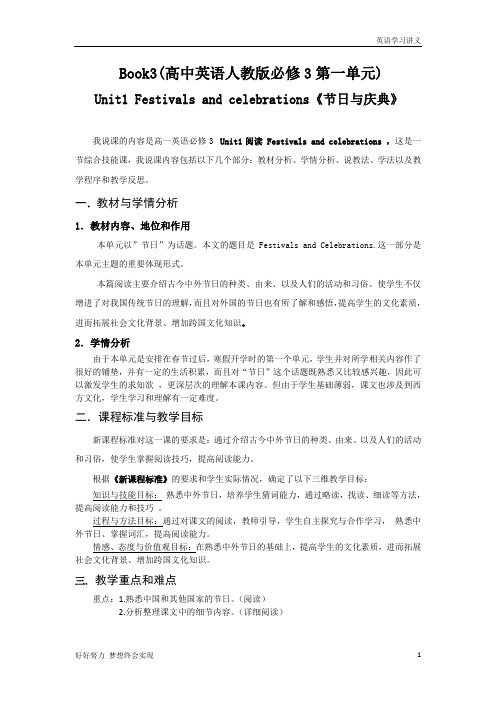
Book3(高中英语人教版必修3第一单元) Unit1 Festivals and celebrations《节日与庆典》我说课的内容是高一英语必修3Unit1阅读 Festivals and celebrations ,这是一节综合技能课,我说课内容包括以下几个部分:教材分析、学情分析、说教法、学法以及教学程序和教学反思。
一.教材与学情分析1.教材内容、地位和作用本单元以”节日”为话题。
本文的题目是Festivals and Celebrations.这一部分是本单元主题的重要体现形式。
本篇阅读主要介绍古今中外节日的种类、由来、以及人们的活动和习俗。
使学生不仅增进了对我国传统节日的理解,而且对外国的节日也有所了解和感悟,提高学生的文化素质,进而拓展社会文化背景、增加跨国文化知识。
2.学情分析由于本单元是安排在春节过后,寒假开学时的第一个单元,学生并对所学相关内容作了很好的铺垫,并有一定的生活积累,而且对“节日”这个话题既熟悉又比较感兴趣,因此可以激发学生的求知欲,更深层次的理解本课内容。
但由于学生基础薄弱,课文也涉及到西方文化,学生学习和理解有一定难度。
二.课程标准与教学目标新课程标准对这一课的要求是:通过介绍古今中外节日的种类、由来、以及人们的活动和习俗,使学生掌握阅读技巧,提高阅读能力。
根据《新课程标准》的要求和学生实际情况,确定了以下三维教学目标:知识与技能目标:熟悉中外节日,培养学生猜词能力,通过略读,找读、细读等方法,提高阅读能力和技巧。
过程与方法目标:通过对课文的阅读,教师引导,学生自主探究与合作学习,熟悉中外节日、掌握词汇,提高阅读能力。
情感、态度与价值观目标:在熟悉中外节日的基础上,提高学生的文化素质,进而拓展社会文化背景、增加跨国文化知识。
三. 教学重点和难点重点:1.熟悉中国和其他国家的节日。
(阅读)2.分析整理课文中的细节内容。
(详细阅读)难点:用所学知识谈论中国和其他国家的节日和庆祝方式。
新版人教版必修三课文unit1 WHY DO WE CELEBRATE FESTIVALS知识讲解
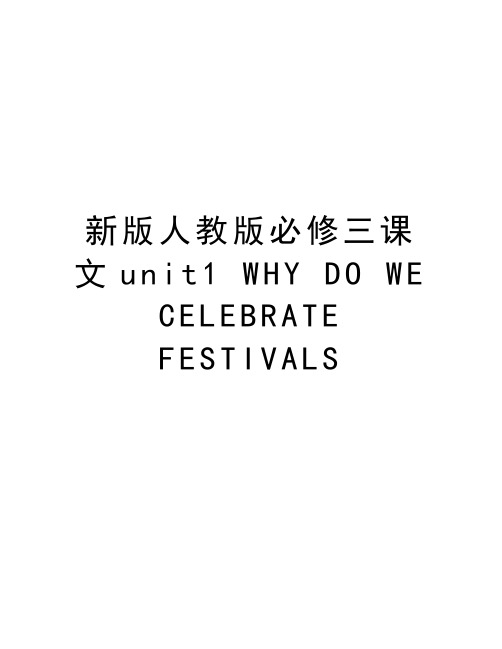
新版人教版必修三课文u n i t1W H Y D O W EC E L E B R A T EF E S T I V A L S精品资料人教版高中英语必修三Unit 1WHY DO WE CELEBRATE FESTIVALS?Festivals are celebrated all around the world. They have a wide range of origins, such as the seasons of the year, religions, famous figures, and important events. Every festival has its different customs and unique charms. However, no matter how different they may seem, all over the world, the spirit of sharing joy, gratitude, love,or peace is common in all festivals.Of all the traditional festivals, the harvest festival can be found in almost every culture. This important agricultural festival takes place after all the crops have been gathered in. People celebrate to show that they are grateful for the year's supply of food. In ancient Egypt, the harvest festival was celebrated during the springtime —the Egyptian harvest season. It featured a parade and a great feast with music, dancing, and sports. Today, in some European countries, people decorate churches and town halls with flowers and fruit, and get together to celebrate over a meal. During theMid-Autumn Festival in China, families gather to admire the shining moon and enjoy delicious mooncakes.Customs play a significant role in festivals, but sometimes they can change over time. With the development of modern society and the spread of new ideas, some traditions may fade away and others may be established. One example is the typical Chinese Spring Festival custom of lighting firecrackers to drive away the evil spirits and celebrate the new year. Nowadays, many big cities have given up this custom in order to avoid air pollution. Another example is Halloween, which slowly became an exciting festival for children, in spite of its religious origins.Festivals are becoming more and more commercial, with businesses taking advantage of the celebrations. Online shopping websites and social media apps have made it much easier for the public to spend more on gifts for their loved ones. Although some believe festivals should not be commercialised, others believe the increase in spending is good for the economy and public happiness.Festivals are an important part of society. They reflec t people’s wishes, beliefs, faiths and attitudes towards life. They are occasions that allow us to relax and enjoy life, and forget about our work for a little while. They help us understand where we came from, who we are, and what to appreciate. And if you study festivals carefully, you may be surprised to find that different cultures actually have a lot in common after all.仅供学习与交流,如有侵权请联系网站删除谢谢2。
新人教版高中英语必修三1人教版高中英语必修三_Unit1_(1)精品ppt课件
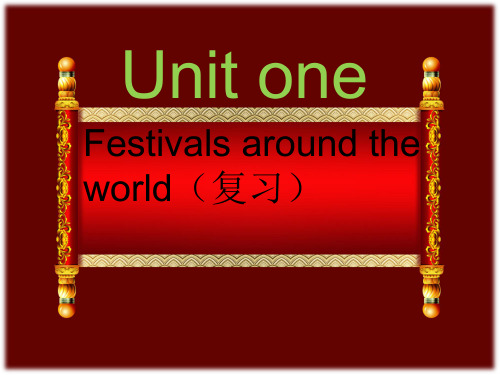
D .hunting
Scanning:
T or F
1.The ancient people need not worry about
their food . F
2.Halloween is a festival intended to honor
2. People are grateful that food is ready for winter and the hard farm work is finished.
3. At spring festivals, people usually have dances, carnivals and other activities to celebrate the end of winter and the coming of spring.
Unit one
Festivals around the world(复习)
Spring Festival
Dragon Boat
Festival
Mid-autumn Festival
The Lantern Festival
Children’ s Day
National
e Day
International Labour Day
Match the festivals with the purpose of celebrating.
1.Obon
a
2.Dragon Boat Festival e
3.Halloween
C
4.Thanksgiving Day f
5.Easter b
6. Mid-autumn Festival
人教版高中英语必修三unit1教案
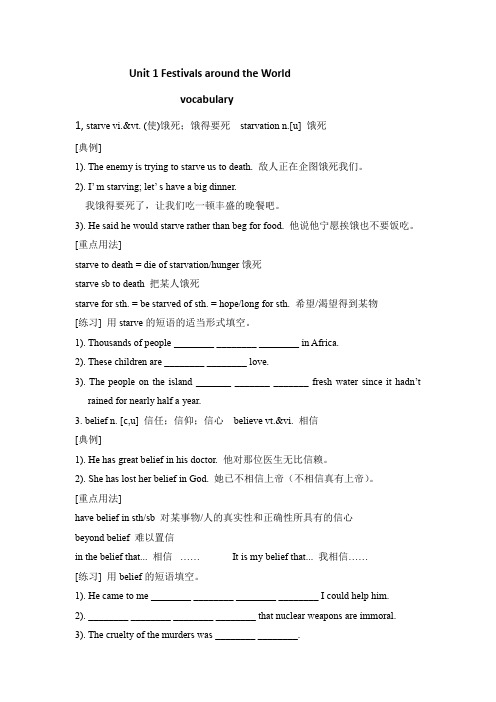
Unit1Festivals around the Worldvocabulary1,starve vi.&vt. (使)饿死;饿得要死starvation n.[u] 饿死[典例]1). The enemy is trying to starve us to death. 敌人正在企图饿死我们。
2). I’ m starving; let’ s have a big dinner.我饿得要死了,让我们吃一顿丰盛的晚餐吧。
3). He said he would starve rather than beg for food. 他说他宁愿挨饿也不要饭吃。
[重点用法]starve to death = die of starvation/hunger饿死starve sb to death 把某人饿死starve for sth. = be starved of sth. = hope/long for sth. 希望/渴望得到某物[练习] 用starve的短语的适当形式填空。
1). Thousands of people ________ ________ ________ in Africa.2). These children are ________ ________ love.3). The people on the island _______ _______ _______ fresh water since it hadn’trained for nearly half a year.3. belief n. [c,u] 信任;信仰;信心believe vt.&vi. 相信[典例]1). He has great belief in his doctor. 他对那位医生无比信赖。
2). She has lost her belief in God. 她已不相信上帝(不相信真有上帝)。
新人教版必修三Unit1Festivalaroundtheworld单元教案
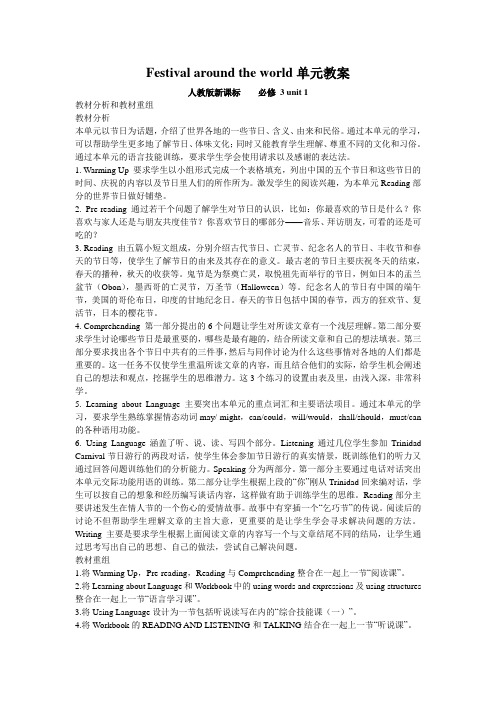
Festival around the world单元教案人教版新课标必修 3 unit 1教材分析和教材重组教材分析本单元以节日为话题,介绍了世界各地的一些节日、含义、由来和民俗。
通过本单元的学习,可以帮助学生更多地了解节日、体味文化;同时又能教育学生理解、尊重不同的文化和习俗。
通过本单元的语言技能训练,要求学生学会使用请求以及感谢的表达法。
1. Warming Up 要求学生以小组形式完成一个表格填充,列出中国的五个节日和这些节日的时间、庆祝的内容以及节日里人们的所作所为。
激发学生的阅读兴趣,为本单元Reading部分的世界节日做好铺垫。
2. Pre-reading 通过若干个问题了解学生对节日的认识,比如:你最喜欢的节日是什么?你喜欢与家人还是与朋友共度佳节?你喜欢节日的哪部分——音乐、拜访朋友,可看的还是可吃的?3. Reading 由五篇小短文组成,分别介绍古代节日、亡灵节、纪念名人的节日、丰收节和春天的节日等,使学生了解节日的由来及其存在的意义。
最古老的节日主要庆祝冬天的结束,春天的播种,秋天的收获等。
鬼节是为祭奠亡灵,取悦祖先而举行的节日,例如日本的盂兰盆节(Obon),墨西哥的亡灵节,万圣节(Halloween)等。
纪念名人的节日有中国的端午节,美国的哥伦布日,印度的甘地纪念日。
春天的节日包括中国的春节,西方的狂欢节、复活节,日本的樱花节。
4. Comprehending 第一部分提出的6个问题让学生对所读文章有一个浅层理解。
第二部分要求学生讨论哪些节日是最重要的,哪些是最有趣的,结合所读文章和自己的想法填表。
第三部分要求找出各个节日中共有的三件事,然后与同伴讨论为什么这些事情对各地的人们都是重要的。
这一任务不仅使学生重温所读文章的内容,而且结合他们的实际,给学生机会阐述自己的想法和观点,挖掘学生的思维潜力。
这3个练习的设置由表及里,由浅入深,非常科学。
5. Learning about Language 主要突出本单元的重点词汇和主要语法项目。
人教版高中英语必修3人教版必修三Unit1Festivals around the world教案Period 1 Warming up and Reading
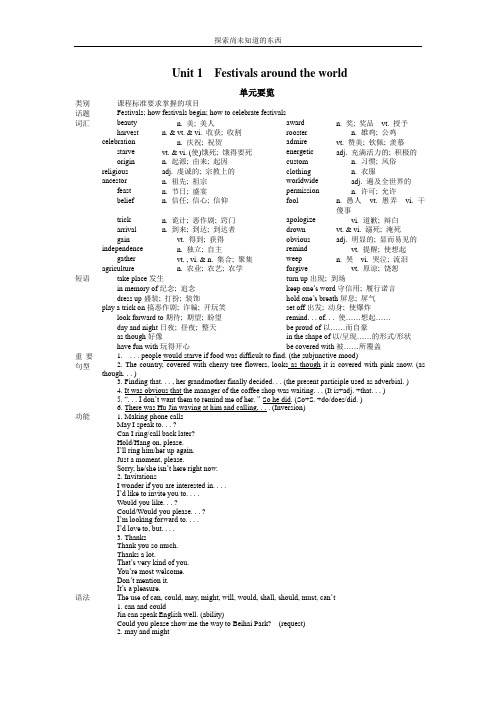
Unit 1Festivals around the world单元要览类别课程标准要求掌握的项目话题Festivals; how festivals begin; how to celebrate festivals词汇beauty n. 美; 美人award n. 奖; 奖品vt. 授予harvest n. & vt. & vi. 收获; 收割rooster n. 雄鸡; 公鸡celebration n. 庆祝; 祝贺admire vt. 赞美; 钦佩; 羡慕starve vt. & vi. (使)饿死; 饿得要死energetic adj. 充满活力的; 积极的origin n. 起源; 由来; 起因custom n. 习惯; 风俗religious adj. 虔诚的; 宗教上的clothing n. 衣服ancestor n. 祖先; 祖宗worldwide adj. 遍及全世界的feast n. 节日; 盛宴permission n. 许可; 允许belief n. 信任; 信心; 信仰fool n. 愚人vt. 愚弄vi. 干傻事trick n. 诡计; 恶作剧; 窍门apologize vi. 道歉; 辩白arrival n. 到来; 到达; 到达者drown vt. & vi. 溺死; 淹死gain vt. 得到; 获得obvious adj. 明显的; 显而易见的independence n. 独立; 自主remind vt. 提醒; 使想起gather vt. , vi. & n. 集合; 聚集weep n. 哭vi. 哭泣; 流泪agriculture n. 农业; 农艺; 农学forgive vt. 原谅; 饶恕短语take place发生turn up出现; 到场in memory of纪念; 追念keep one’s word守信用; 履行诺言dress up盛装; 打扮; 装饰hold one’s breath屏息; 屏气play a trick on搞恶作剧; 诈骗; 开玩笑set off出发; 动身; 使爆炸look forward to期待; 期望; 盼望remind. . . of. . . 使……想起……day and night日夜; 昼夜; 整天be proud of以……而自豪as though好像in the shape of以/呈现……的形式/形状have fun with玩得开心be covered with被……所覆盖重要句型1. . . . people would starve if food was difficult to find. (the subjunctive mood)2. The country, covered with cherry tree flowers, looks as though it is covered with pink snow. (as though. . . )3. Finding that. . . , her grandmother finally decided. . . (the present participle used as adverbial. )4. It was obvious that the manager of the coffee shop was waiting. . . (It is+adj. +that. . . )5. “. . . I don’t want them to remind me of her. ” So he did. (So+S. +do/does/did. )6. There was Hu Jin waving at him and calling, . . . (Inversion)功能 1. Making phone callsMay I speak to. . . ?Can I ring/call back later?Hold/Hang on, please.I’ll ring him/her up again.Just a moment, please.Sorry, he/she isn’t here right now.2. InvitationsI wonder if you are interested in. . . .I’d like to invite you to. . . .Would you like. . . ?Could/Would you please. . . ?I’m looking forward to. . . .I’d love to, but. . . .3. ThanksThank you so much.Thanks a lot.That’s very kind of you.You’re most welcome.Don’t mention it.It’s a pleasure.语法The use of can, could, may, might, will, would, shall, should, must, can’t1. can and couldJin can speak English well. (ability)Could you please show me the way to Beihai Park? (request)2. may and mightMay we see the awards for the teams? (permission; request)She might give you some new clothing. (possibility)3. will and wouldThe Spring Festival is the most fun. The whole family will come for dinner. (promise; agreement) Often he would dress up like a rich man. (past habit; custom)4. shall and shouldThe harvest festival begins on Sunday. We shall be there with our friends. (promise; agreement) You should arrive at the airport two hours before he goes. (advice)5. must and can’tWang Feng wins an award every year. He must be very strong. (speculation)You must be joking. That can’t be true. (guessing)教学重点1. Get students to know about festivals around the world.2. Have students learn some useful new words and expressions about festivals and customs and let them learn effective ways to remember English vocabulary.3. Enable students to grasp and use the expressions of request and thanks.4. Let students learn the new grammar item: the use of can, could, may, might, will, would, shall, should, must and can’t.5. Develop students’ listening, speaking, reading and writing abilities.教学难点1. Enable students to master the use of can, could, may, might, will, would, shall, should, must and can’t.2. Let students learn to write a different ending of a story.3. Develop students’ integrative skills.课时安排Periods needed: 7Period 1 Warming up and readingPeriod 2 Learning about language: Important language points Period 3 Learning about language: GrammarPeriod 4 Using language: Listening and speakingPeriod 5 Using language: Extensive readingPeriod 6 Using language: Speaking and writingPeriod 7 Revision: Summing up and learning tipPeriod 1Warming up and reading整体设计教材分析This is the first teaching period of this unit. At the beginning of the class, the teacher can lead in the topic of the unit by having a free talk with students about their winter holidays and the Spring Festival.The Warming Up is intended to have students start thinking about the variety of events and festivals that are celebrated in China, and connect them with seasons of the year and reasons for the celebrations. The teacher can use this part to introduce information that Chinese students should have about their country’s cultural events.The Pre-reading is a continuation of the Warming Up and it moves the discussion to a more personal level. It is intended to help students enter imaginatively into a discussion of festivals and their importance to the society. It also directs their attention to the variety of events and activities those festivals include. The teacher should let students discuss the questions and predict what kind of information will be introduced in the Reading.The reading passage titled FESTIV ALS AND CELEBRATIONS briefly describes the earliest kinds of festivals with the reasons for them, and then four different kinds of festivals that occur in most parts of the world. Encourage students to look at the pictures and the heading of each section to guess what the text might be about. Then let them skim for the general idea for each section, and scan for further understanding. Because this passage introduces a lot of useful new words and expressions which are only used for festivals, in order not to let students feel much difficult, the teacher should deal with any language problems while they are reading. After reading, students are required to do the four exercises in the Comprehending to see how much they have understoodthe reading passage. The teacher can first let them work in pairs or in groups to find the answers cooperatively, and then check their answers with the whole class.To consolidate the contents of the reading passage, students should be required to talk about festivals in their own words at the end of the class. In order to arouse students’ interest, the teacher can hold a competition between groups.教学重点1. Let students learn more about history and basic knowledge of festivals.2. Get students to learn different reading skills.教学难点1. Develop students’ reading ability.2. Enable students to talk about festivals and celebrations.三维目标知识目标1. Get students to learn the useful new words and expressions in this part: beauty, harvest, starve, origin, religious, ancestor, Mexico, feast, bone, belief, poet, arrival, gain, independence, gather, agriculture, award, rooster, admire, energetic, Easter, clothing, Christian, custom, take place, in memory of, dress up, play a trick on, look forward to, day and night, as though, have fun with2. Let students learn about history and basic knowledge of festivals both in and out of China.能力目标1. Develop students’ reading ability and let them learn different reading skills.2. Enable students to talk about festivals and celebrations.情感目标1. Stimulate students’ love for their own national culture and customs.2. Develop students’ sense of cooperative learning.教学过程设计方案(一)→Step 1 Leading-inHave a free talk with students. Ask them the following questions:Did you have a good time in your winter holidays?When did you feel most happy and excited? Why?(At the Spring Festival. Because it’s the most important festival in our country. . . )→Step 2 Warming up1. Let students brainstorm the other Chinese festivals.(Lantern Festival, Pure Brightness Festival, Dragon Boat Festival, Mid-Autumn Festival, New Year’s Day, Chung Yeung Festival. . . )2. Let students read the information about Chinese festivals below and discuss another three Chinese festivals:When does the festival come?What do people celebrate?What do people do?Festivals Date Festivals DateNew Year January 1st Teachers’ Day September 10thInternational Women’sDayMarch 8th National Day October 1stArbor Day March 12th The Spring Festival Lunar New YearInternational Labor Day May 1st Dragon Boat Festival the fifth day of the fifth lunar month International Children’sDayJune 1st Mid-Autumn Festival the 15th day of the 8th lunar month Army Day August 1st Lantern Festival the 15th day of the 1st lunar month Chinese Youth Day May 4th Pure Brightness Day April the fifth3. Ask students to fill in the following form and ask some to share their opinions with the whole class. The first one is given as an example.Festivals Time of year/date What it celebrates What people doMid-Autumn Festival autumn/fall the beauty of the fullmoon, harvest, time withfamily and friends give/eat moon cakes and watch the full moon with family and friends4. Talk about some foreign festivals with students.(Christmas, April Fools’ Day, Easter, Halloween, Valentine’s Day, Thanksgiving Day, . . . )→Step 3 Pre-reading1. Let students discuss the following questions:What festivals or celebrations do you have in your city or town? What part of a festival do you like best—the activities, the music, the sights, the food or the people who visit?2. Ask students to look at the pictures and title of the passage in Reading. Discuss in pairs what kind of information will be introduced in the passage.→Step 4 Reading1. Fast readingAsk students to skim the reading passage and then fill in the following chart.Kinds of Festivals Names of Festivals Countries FestivalsFestivalsHarvestSpring(Let students look through the chart and then read the text silently. Three minutes later, check the answers with the whole class. Show the suggested answers on the screen. )2. Intensive readingAllow students to read carefully this time to understand the main ideas of each paragraph and the important details, and then finish the following:1)Choose the best answer to each question or to finish each sentence according to the text.(1)Why do Japanese people light lamps during the Festival of the Dead?A. Because they want to make the festival colorful.B. Because they want to light up their rooms.C. Because they want to light up their way.D. Because they want to lead their ancestors to return to earth.(2)Which of the following was not mentioned as a famous person in the text?A. Mohandas Gandi.B. Christopher Columbus.C. Abraham Lincoln.D. Qu Yuan.(3)The place where people will usually decorate churches and town halls with flowers andfruits is ______________.A. IndiaB. AmericaC. EuropeD. China(4)Easter is held in memory of the return of Jesus for Christians and also celebrates ______________.A. the coming of springB. the autumn harvestC. the Lunar New YearD. the end of a yearSuggested answers: (1)D(2)C(3)C(4)A2)Use the information from the reading passage to answer the following questions.(1)What are festivals of the dead usually for?(2)What makes autumn festivals happy events?(3)What do people usually do at spring festivals?(4)What is one important reason to have festivals and celebrations?(5)Compare the festivals of the dead in Mexico, Japan and China. What things are similar? What things are different?3. Reading and discussionRead the text a third time and then work in pairs to do the following.1)Based on the reading passage, what do most festivals seem to have in common? Why do you think these things might be important to people everywhere? Talk with your partner and fill in the chart below.Three common things Reasons why they are important to people everywhere1.2.3.2)Discuss in pairs which festivals you think are the most important and which are the most fun. Then fill in the chart with your ideas.Type of festival Example of festival Reasons for your choice Most importantMost fun(Let students have enough time to read the passage carefully and discuss the questions and charts with their partners. Encourage them to expand their answers according to their own experiences. )4. ExplanationHelp students analyze some difficult, long and complex sentences and guess the meanings of some new words. Encourage them to try to deal with the language points in the context.Discuss the following important sentences and phrases in the passage.1)Some festivals are held to honour the dead, or to satisfy the ancestors, who might return either to help or to do harm.2)in memory of3)India has a national festival on October 2 to honour Mohandas Gandhi, the leader who helped gain India’s independence from Britain.4)People are grateful because their food is gathered for the winter and the agricultural work is over.5)The most energetic and important festivals are the ones that look forward to the end of winter and to the coming of spring.6)The country, covered with cherry tree flowers, looks as though it is covered with pink snow.Suggested explanations:1)The sentence contains a non-restrictive attributive clause who might return either to help or to do harm. It means people hold some festivals either to show respect to the dead or to make their ancestors happy in case they might come back to do harm.2)in memory of: serving to recall sb. , to keep him fresh in people’s mindsHe wrote a poem in memory of his dearest wife, who died in an accident.in honor of: showing great respect or high public regard3)the leader who helped gain India’s independence from Britain: a noun phrase followed by an attributive clause as the appositive4)two clauses for reason5)energy n. → energetic adj. : full of or done with energylook forward to: “to” is a preposition here.I’m looking forward to hearing from you.be devoted to; be/get used to; get down to; stick to. . .6)covered with cherry tree flowers: a past participle phrase equal to “which is covered with cherry tree flowers”as though: as ifHe talks as though he knew all about it.He looks as if he had seen a ghost.5. Reading aloud and underliningAsk students to read the passage aloud to the tape and let them pay attention to the pronunciation of each new word and the pauses within each sentence. Tell them to pick out all the useful expressions or collocations from the passage while reading and copy them to the notebook after class as homework.→Step 5 ConsolidationAsk students to talk about festivals in their own words according to the text. Then let them complete the following passage with proper words or phrases.There are all kinds of festivals and ______________ around the world, which are held for different ______________. The ancient festivals were mainly held at three times a year—the end of the cold ______________, planting in spring and ______________ in autumn. Some festivals are held to ______________ the dead or ______________ the ancestors, who might return either to help or ______________, while other festivals are held to honor famous people or to the ______________, such as Dragon Boat Festival, Columbus Day, and so on. Harvest and ______________ festivals are happy events because their food is ______________ for the winter and the ______________ work is over, to which Mid Autumn Festival belongs. And the most ______________ and important festivals are the ones that ______________ the end of winter and to the coming of ______________ such as the Lunar New Year, at which people have a very ______________.Suggested answers: celebrations; reasons; weather; harvest; honor; to satisfy; to do harm; gods; Thanksgiving; gathered; agricultural; energetic; look forward to; spring; good time→Step 6 Homework1. Learn the useful new words and expressions in this part by heart.2. Read the reading passage again and again and try to talk about festivals both in and out of China.设计方案(二)→Step 1 Leading in the topic by learning vocabulary about festivals1. Make a circle on the blackboard and write the word “FESTIV AL” in it.2. Ask students, “We have learned ‘festival’. Can you name some festivals? ”3. Students list as many fest ivals as possible. Then the teacher adds some students can’t think of, such as Halloween, Easter, Thanksgiving, Valentine’s Day.4. Let students read them aloud and try to learn them by heart.→Step 2 Warming up by talking about festivalsWork in groups and list three more Chinese festivals that you know. Discuss when they take place, what they celebrate and what people do at that time. Then tell the group which festival is their favorite and why.Festivals Time of year/date What it celebrates What people doMid-Autumn Festival autumn/fall the beauty of the fullmoon, harvest, time withfamily and friends give/eat moon cakes and watch the full moon with family and friends→Step 3 Predicting by looking and discussing1. Look at the pictures and title of the reading passage and discuss in pairs what the passage might be about.2. Two or three students are to give their opinions.→Step 4 Reading1. Give students 2 minutes, and ask them to skim the passage for information to tell if the following sentences are True or False.1)The ancient people needn’t worry about their food. (F)2)Halloween used to be a festival intended to honor the dead. (T)3)Qu Yuan was a great poet who people honor a lot in China. (T)4)The Mid-autumn Festival is held to celebrate the end of autumn. (F)5)Easter celebrates the birth of Jesus. (F)2. Give students 5 minutes to read the passage carefully, and complete the chart according to the passage.Festivals of the Dead Obon in Japan___________________HalloweenFestivals to Honor People ________________________________A national festival in____________Harvest Festivals _________ in European countries_________ in China and JapanSpring Festivals ________________Carnivals in some Western countries________________________________ in Japan3. Listening and reading aloudPlay the tape of the text for students and let them pay attention to the pronunciation of each new word and the pauses within each sentence. Then ask them to read the text aloud to the tape.→Step 5 Closing down by spoken practice1. Have students get prepared in 3 minutes or so and then ask them to talk about festivals and celebrations.2. Ask as many students as possible to have a try in front of the class.→Step 6 Homework1. Go over the text and try to learn all the useful words and expressions in this part by heart.2. Finish the exercises in Comprehending on Page3.板书设计Unit 1Festivals around the worldFestivals and celebrationsKinds of Festivals Names of Festivals Countries FestivalsFestivalsHarvestSpring活动与探究Group discussion & speechAs is known from the reading passage, festivals of all kinds are celebrated around the world. Most festivals have celebrations that include food, music, clothing and dances. These events originated from some similar ideas, but they take different forms in different regions and societies. What festivals and celebrations do you know all over the world? Have you ever taken part in them and enjoyed yourself? Discuss festivals in groups and then make speeches.Step 1: The teacher divides the class into four groups and gives the tasks to students in each group. Group 1 will list the festivals around the world as many as possible, and then categorize them according to the origins of these festivals. And they should prepare for a short speech. Group 2 will discuss two traditional Chinese festivals and prepare for their presentation. Group 3 will discuss two Western festivals and prepare for their presentation. Group 4 will discuss the differences between Chinese festivals and Western festivals, then contrast and compare their styles, celebrations, dates and so on. And they should prepare for a short speech.Step 2: Groups 1, 2 and 3 give their speeches on the festivals they have discussed. Group 4 gives their speech on the differences between Chinese festivals and Western festivals.Step 3: The teacher makes proper remarks about students’ speeches and sums up the different cultural practices between China and other countries according to them.。
高中英语必修三unit1教案
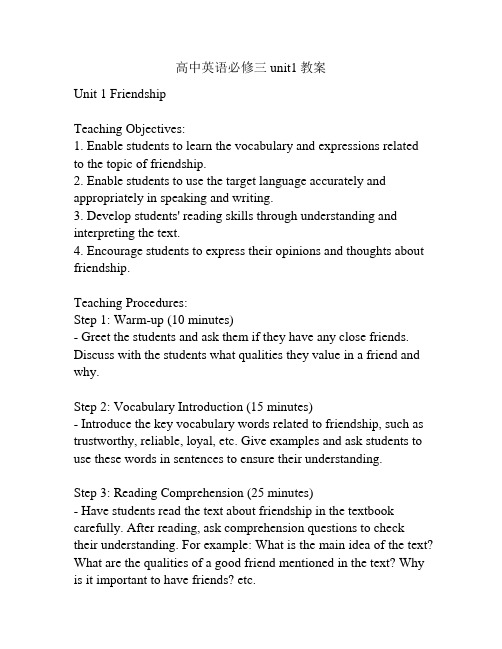
高中英语必修三unit1教案Unit 1 FriendshipTeaching Objectives:1. Enable students to learn the vocabulary and expressions relatedto the topic of friendship.2. Enable students to use the target language accurately and appropriately in speaking and writing.3. Develop students' reading skills through understanding and interpreting the text.4. Encourage students to express their opinions and thoughts about friendship.Teaching Procedures:Step 1: Warm-up (10 minutes)- Greet the students and ask them if they have any close friends. Discuss with the students what qualities they value in a friend and why.Step 2: Vocabulary Introduction (15 minutes)- Introduce the key vocabulary words related to friendship, such as trustworthy, reliable, loyal, etc. Give examples and ask students to use these words in sentences to ensure their understanding.Step 3: Reading Comprehension (25 minutes)- Have students read the text about friendship in the textbook carefully. After reading, ask comprehension questions to check their understanding. For example: What is the main idea of the text? What are the qualities of a good friend mentioned in the text? Why is it important to have friends? etc.Step 4: Group Discussion (20 minutes)- Divide the class into small groups and ask them to discuss the following questions: What do you think makes a good friend? Do you think it's important to have many friends or just a few close friends? Why? Have each group present their ideas to the class. Step 5: Writing Exercise (25 minutes)- Ask students to write a short paragraph about their best friend, describing their qualities and why they appreciate them. Encourage them to use the vocabulary and expressions they have learned in this unit.Step 6: Pair Activity (15 minutes)- Pair up the students and ask them to interview each other about their friendships. They should ask questions like: How did you meet your best friend? What do you like most about your friend? Do you have any interesting or funny stories about your friendship? etc. After the interview, have some students share their findings with the class.Step 7: Homework (5 minutes)- Assign homework that reinforces the target language and skills learned in this unit. For example, students can write a letter to a friend, expressing their appreciation and sharing a memorable experience they had together.Note: This is a general outline for a teaching plan. The duration of each step may vary depending on the class and teaching style. It isimportant for the teacher to adapt the plan to suit the needs and abilities of their students.。
新人教版高中英语必修三Unit1 Reading and Thinking课件
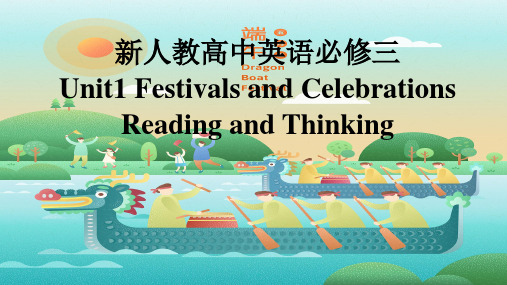
To honour people
Lead-in Watch a video about festivals around the world. 1.What festivals can you find in this video?
para5. _I_m__p_o_r_ta_n__ce_ of festivals importance, commercialization(商业化), harvest,common,changes
4 read for details-para1:common What do most festivals seem to have in common?
Body supporting details
It describes the harvest festival, customs changes and commercialized festivals
conclusion
It explains the significance of festivals
To show that they are grateful for the why year's supply of food.
In ancient Egypt: it featured a parade and a great feast with music, dancing and sports.
Q.WRhaetakdinfdoorfswtrriuticntguisrethe passage?
- 1、下载文档前请自行甄别文档内容的完整性,平台不提供额外的编辑、内容补充、找答案等附加服务。
- 2、"仅部分预览"的文档,不可在线预览部分如存在完整性等问题,可反馈申请退款(可完整预览的文档不适用该条件!)。
- 3、如文档侵犯您的权益,请联系客服反馈,我们会尽快为您处理(人工客服工作时间:9:00-18:30)。
2020学年人教版高中英语必修三
Festivals around the World
张北一中高一年级:
一说教材
1.教材的地位和作用:
Festivals around the world是人教版新课标高中英语必修三第一单元的内容。
本单元围绕festivals around the world(世界各地的节日)这一主题展开进行听、说、读、写等多种教育活动。
让学生不仅对本国的节日增进理解,而且对外国的节日也有所感悟,从而提高学生的社会文化素质,加强跨国文化意识。
2. 教学目标:
(1)知识与技能:
①简述各国节日的由来、作用以及人们在节日中的习俗表现;
②掌握生词、词组、句型的用法。
(2)过程与方法
①通过开展小组活动以及提问讨论的方式,引导学生积极与人合作,相互学习帮助,培养团队意识;
②通过同学与老师之间的交流,在教学过程中提高语言表达能力,初步培养学生活学活用的能力。
( 3 ) 情感态度与价值观
了解世界文化的多样性以及增强对本国传统特色文化的保护意识,,增强跨文化交际能力。
3. 教学重难点:
重点:①了解世界各地各种的节日名称、起源以及庆祝方式等;
②学习并掌握本课单词以及短语。
二说学情
“节日”是学生既熟悉又比较感兴趣的话题,因此可以激发学生的求知欲,更深层次的理解本课内容。
但由于课文也涉及到西方文化,学生学习和理解有一定难度。
三说教法学法
1.教法
基于本课题的特点,决定采用以任务教学法为主,以问答法、讨论法为辅的教学方法。
2. 学法
学法上,我提倡“把学习的主动权还给学生”,教会学生主动预习、自主思考、系统小结;同时进行“自主、合作、探究”的学习方式,具体为讨论法、朗读法和勾画圈点法。
3. Teaching aids(教具):多媒体和常规教具。
四教学过程:
Step1 Warming-up
1.Greetings: Good morning, boys and girls .Happy New Year.
2.Talk about winter vocation: Good morning .Happy New Year.
设计意图:通过谈论新年,从而引入本单元的话题:festivals around the world.
Step2.Leading-in(导入)
首先通过幻灯片展示几幅图片,均为一些与节日有关的图片,要求学生对以下问题进行思考并讨论:
1.说一下图片中都展示的是哪个节日?
2.人们在节日中都做什么?
3.你还知道中国的或外国哪些节日?人们怎么来庆祝这些节日?
设计意图:
1.通过谈论中外的不同节日,既让学生了解了中国的风俗习惯,唤起学生的爱
国情感和民族自豪感,又了解到世界文化风俗,加强跨文化意识。
2.要求学上用英文进行讨论并回答问题,能够锻炼学生的口语能力。
Step3 Fast Reading(快速阅读)
要求学生对Reading部分进行快速阅读,了解文章大意,并回答以下问题:
1.文中介绍了几种节日?分别是什么?
2.你喜欢哪一种节日?为什么?
设计意图:
通过快速阅读,锻炼学生的阅读技巧,使学生通过快速阅读了解文章大意,为进一步学习做铺垫。
Step4 Intensive Reading(精读)
要求学生对全文进行详细阅读,并完成以下任务:
1.划出本单元的重点词汇、短语及句子。
2.回答问题:在不同的节日中,人们是怎样庆祝节日的?
Step4 Analysis of important knowledge points(重点知识解析)
1.教师讲解总结重点词汇、短语的用法。
Take place, in memory of, dress up, play a trick on, look forward to, day and night, as though, have fan with, turn up, keep one’s word, hold one’s breath, set off, remind…of…Parking lot
2.重点句子解析(讲解由大屏幕所展示的重点句子,分析句子结构,句子含义,
句子中的词语)
设计意图:使学生全面,牢固地掌握本单元重点知识,并能学以致用。
Step5. Group work
Festivals are created: 设计一个节日,包含以下内容:
When the festival take place?
What the festival is for ?
What the people do at the festival?
What the people eat at the festival?
设计意图:而通过让学生自己创造一个节日,达到让学生运用已学知识进行创新运用的能力。
Step6 Homework(作业)
1.要求学生将课上所讲的单词及词组在课下进行复习,达到背诵及运用的效果。
2.完成课后练习。
五板书设计。
